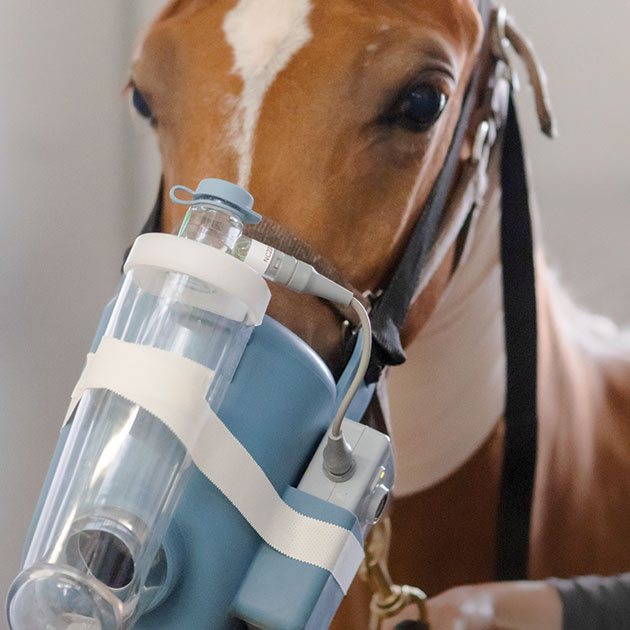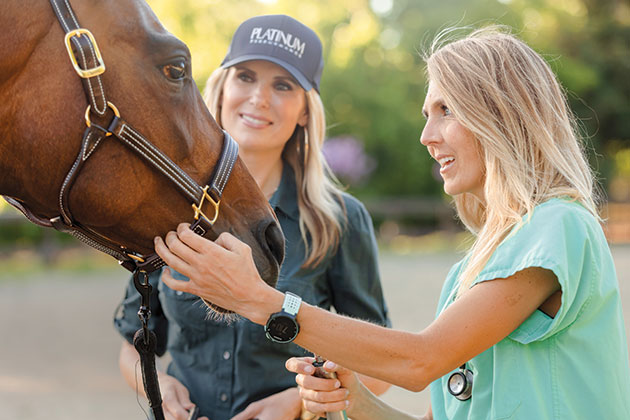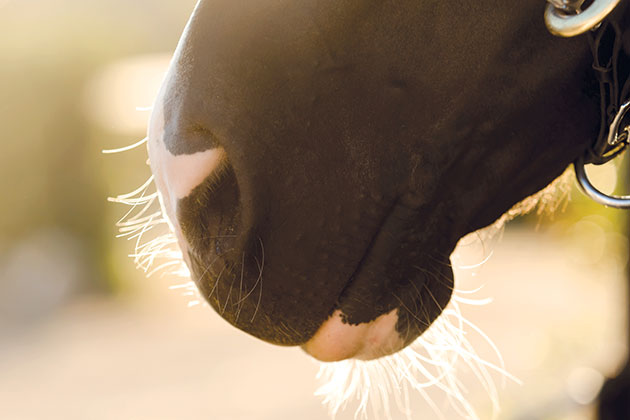Treatment of Equine Asthma Requires Consistent Environmental Management
There aren’t many things more frustrating for a horse owner than trying to treat a horse with a chronic cough and seeing little to no improvement. With an estimated 60% of pleasure horses and 80% of racehorses suffering from equine asthma, the root cause of the cough might not be from one of the more well-known culprits like viral infections or seasonal allergies. In humans and horses, the incidence of asthma is on the rise with no real cure for the disease in sight — only treatment of the symptoms. This leads to many frustrated veterinarians and owners grasping for effective tools to support afflicted horses. One such veterinary researcher is Dr. Michelle Coleman of the University of Georgia’s College of Veterinary Medicine. At the UGA campus in Athens, she has devoted much of her time and recent research to studying asthmatic horses to better understand the role of the gastrointestinal tract — and more specifically, obesity — in the disease process. Dr. Coleman is a leading researcher and talented veterinarian that is providing her advice on how to help horses breathe easier.

“Asthma, as it stands, is a disease characterized by inflammation of the lower respiratory tract or the lungs and usually manifests in the form of coughing and shortness of breath,” Dr. Michelle Coleman says.
“Asthma, as it stands, is a disease characterized by inflammation of the lower respiratory tract or the lungs and usually manifests in the form of coughing and shortness of breath,” Dr. Michelle Coleman says.
Asthma Defined
The official name for equine asthma has evolved through the years as researchers and veterinarians have learned more about this debilitating condition. “Our knowledge and understanding of equine asthma has lagged behind the human medicine component,” explains Dr. Coleman. “We knew that it was probably similar to some type of human respiratory disease back in the 1960s, and we called this chronic emphysema of the horse.” This term quickly became outdated and replaced by others including chronic bronchitis, small airway disease and chronic obstructive pulmonary disease. “In the early 2000s, we dichotomized our view of horses that had mild disease, and we called the condition inflammatory airway disease,” she says of the horses with minor symptoms like decreased performance or mild coughing. The more severe cases, where horses struggle to breathe at rest, were called recurrent airway obstruction. “Now we’ve shifted away from those terms and adopted a terminology that really better fits with what we’re seeing in the horse compared to the terminology used in human medicine, and that would be mild, moderate or severe asthma depending on the severity of disease,” Dr. Coleman offers.
The new term more accurately encompasses the broader spectrum of breathing concerns in afflicted horses. “Asthma, as it stands, is a disease characterized by inflammation of the lower respiratory tract or the lungs and usually manifests in the form of coughing and shortness of breath,” Dr. Coleman says. Environmental allergens such as molds, spores, dust and pollen are the most common cause of flareups. Once inside the nasal passages, these irritants trigger the immune system to protect the respiratory tract with airway inflammation and mucus production resulting in bronchoconstriction and excess mucus that narrows the airways in the lungs and makes it difficult for the horse to breathe. This results in the classic symptoms of continuous coughing and heavy breathing.
The three types of asthma are based on the level of the symptoms. “The difference is how clinically affected the horses are,” Dr. Coleman explains. “Those that have a respiratory rate and effort that’s increased at rest, we think about those falling into the severe category. Horses with mild or moderate disease may have some clinical signs but at rest look better.” For mild cases, symptoms may be just a change in performance where the horse isn’t running as hard or jumping as high. Clinical symptoms of moderate patients include coughing, while any sign of labored breathing falls into the severe category. What makes the disease complex is that most horses can live with asthma comfortably until something triggers their immune system. “We often see these horses having flares seasonally,” Dr. Coleman says. “They’ll have some kind of episode caused by any sort of change in the environment and then they can have periods of remission, where clinically they look a lot better.” The risk is that once a horse enters a state of severe asthma, even after the symptoms settle down, the horse is more likely to experience another episode at some point in the future.

Environmental allergens such as molds, spores, dust and pollen are the most common cause of flareups. Once inside the nasal passages, these irritants trigger the immune system to protect the respiratory tract with airway inflammation and mucus production resulting in bronchoconstriction and excess mucus that narrows the airways in the lungs and makes it difficult for the horse to breathe. This results in the classic symptoms of continuous coughing and heavy breathing.
Diagnosis
Diagnosing asthma is challenging because oftentimes the disease can live in a state of remission until triggered. “Your horse might look great this month, and next month we start to see clinical signs because of the change in the environmental trigger,” she says. The most important part to detection is the individual’s detailed history, including unusual coughing, mucus, weight loss, wheezing or even just an abnormal change in performance for no apparent reason. “From a diagnostic standpoint, the history and physical exam are the most important things,” Dr. Coleman emphasizes. From there, veterinarians will likely want a bronchoalveolar lavage to examine the presence of inflammatory cells, like neutrophils and eosinophils, in the lungs. In a BAL, sterile saline is flushed into the lower airways of a horse’s lungs and the cells and other substances from the alveoli (tiny air sacs) and small airways are retrieved and analyzed to help diagnose and assess respiratory conditions. “We may also recommend a tracheal wash, which has some limitations from looking at the cell types but can help us rule out something else like pneumonia, which is important to know before we start treatment,” she continues. Ultrasound and radiographs can also be used to rule out any other diseases, including cancer, in the lungs. “Sometimes if we have a strong clinical suspicion, we may just start horses on treatment and see how they respond,” she says. This is commonly done in severe cases where the horse is unusually uncomfortable and diagnostic tests could delay treatment options. In these cases, if the horse responds well to treatment, a positive diagnosis is affirmed.
Evolution of Terms Used to Describe Asthmatic Horses
| Chronic Emphysema, then Broken Wind |
Chronic Obstructive Pulmonary Disease (COPD)
|
|
|||||||||
| 1960s | 1970s | 1980s | 1990s | 2000s | 2010s | Present | |||||
Medical Treatment
While there is no cure for the disease, treatment of the symptoms can help affected horses breathe more normally. The treatment goal is to limit inflammation — especially in the airways. “From a treatment standpoint, our mainstay is corticosteroids, which can be given systemically or nebulized,” says Dr. Coleman. “Using a nebulizer, we can potentially reduce some of the negative side effects delivering medication directly to the lungs.” Corticosteroids commonly used to reduce inflammation include dexamethasone, prednisolone, budesonide and fluticasone. “Bronchodilators are also used to help open up the airways,” she continues. “We think about those allowing a little less stress on the horse when they can breathe better but also allowing the delivery of the nebulized corticosteroids to go deeper in the lungs.” Common bronchodilators include clenbuterol and albuterol to manage airway obstruction and relax airway muscles.
For severe cases, a comprehensive treatment approach consisting of all forms of medical management along with environmental control will most likely be used. Additionally, modifying the horse’s diet can be a key factor in maintaining normal inflammatory pathways in the body, supporting optimal immune function, maintaining an ideal body condition and leaving the horse in a balanced state of health. A comprehensive foundation formula that includes omega-3 fatty acids, antioxidants, amino acids, vitamins and trace minerals provides a baseline for success. Specialty ingredients to provide additional antioxidant support include the extracts of turmeric and tamarind to support healthy levels of inflammation, as well as prebiotics, probiotics and postbiotics that directly support a healthy gut environment, where over 70- 80% of the equine immune system resides. Involving a veterinarian in the care of an asthmatic horse is critical, consulting their expertise on environmental factors, dietary changes, targeted supplementation and medical treatment.

“From a treatment standpoint, our mainstay is corticosteroids, which can be given systemically or nebulized. Using a nebulizer, we can potentially reduce some of the negative side effects by delivering medication directly to the lungs.”
— Dr. Michelle Coleman, University of Georgia College of Veterinary Medicine
Environmental Management Is Key
In addition to dietary intervention, assessing and adjusting a horse’s habitat is essential to a successful outcome. “Medical therapy is nothing without environmental management,” Dr. Coleman states. “Sometimes we won’t even need medical management if we have the proper environmental control.” This requires the commitment to monitor hay, as well as to consistently clean and water the horse’s living spaces. “It really does take a dedicated horse owner to make the changes necessary,” she says. A 2020 University of Lisbon study showed a direct correlation between a horse’s asthmatic symptoms and the owner’s compliance with veterinary-recommended environmental changes. Each study participant received six guidelines including: proper ventilation; avoid stabling; pasture turnout for at least 12 hours; move horse outside for grooming and stall cleaning; dust-free bedding; and to not feed dry hay. After a year, the 38 participants were asked if they had followed the recommendations and only three had. Despite admitting their horses improved when the recommendations were followed, owners were unable to make the necessary long-term changes. “My biggest take home for horse owners would be to have your veterinarian out to the farm to take a look around and make environmental management recommendations,” Dr. Coleman offers. “Then, do what you can. It’s not going to be that we can change everything, but all the medications in the world aren’t going to help if we don’t change the environment.” Ultimately, asthmatic horses need assistance to control what they inhale. A small irritant can trigger an asthma episode that can last for weeks. It’s up to horse owners to help their animals breathe easier.
Ongoing Research
Although asthma is widely studied in horses and people, many unknowns remain about the disease. One highly controversial topic is whether asthma has a direct link to seasonal allergies. While the mechanisms for which the reaction occurs are similar, there’s no data proving seasonal allergies cause asthma. “Some people would probably say yes, but I just don't think we have enough information to understand why a horse is triggered,” Dr. Coleman replies. “What we do know is that skin allergy testing and the immunotherapy that comes with that don't seem to help these horses.” It’s also hard to prove from a research standpoint whether genetics plays a role in asthma. “There’s no shortage of people trying to better understand the genetics,” says the 2007 UGA alumna. “Some studies have been done in horses to show the familial pattern of inheritance, but like many things, this is probably multi-factorial, where a combination of many factors are contributing to development of the disease.” One recent theory is the correlation between asthma and horses having a dorsal displacement of the soft palate, which separates the oral and nasal cavities. In DDSP, the soft palate displaces upwards to sit atop the epiglottis obstructing the opening to the trachea (larynx), and reducing the amount of air a horse breathes in. Research has shown that asthma is a major contributor to DDSP and that by treating the asthma, the displacement can correct itself without surgical intervention — a huge breakthrough.
Dr. Coleman’s research centers on asthma and its association with obesity in horses. Obesity in humans is linked with various classifications of asthma and the same seems to be true for horses and the disease. “It’s a clinical impression that we commonly see obese asthmatic horses, and that poses a treatment challenge for us,” she says. “It can be challenging to treat those horses with corticosteroids because of the risk of laminitis.” What she’s found is manifestation of the disease and the levels of inflammation are increased in heavier horses. “While asthmatic horses tend to lose weight as a result of the disease, they develop asthma in the face of their obesity,” she adds. Interestingly enough, the microbiome of obese horses is also different than nonobese horses, and Dr. Coleman is working to learn more about the involvement of gut bacteria and what it could mean for future treatment options. “If we can modify what’s happening in the GI tract, I think that we can really affect body systems beyond the gut, including the respiratory tract,” she says. “What goes in matters, and providing the body what it needs in the right way is the next step to personalize medicine and improve gut health, which in turn could improve respiratory health.” Her cutting-edge research could change the face of how equine patients are fed and medically treated, something Dr. Coleman is extremely passionate about. “I do think we have some new good things coming to the future that will continue to make these horses better,” she concludes.


